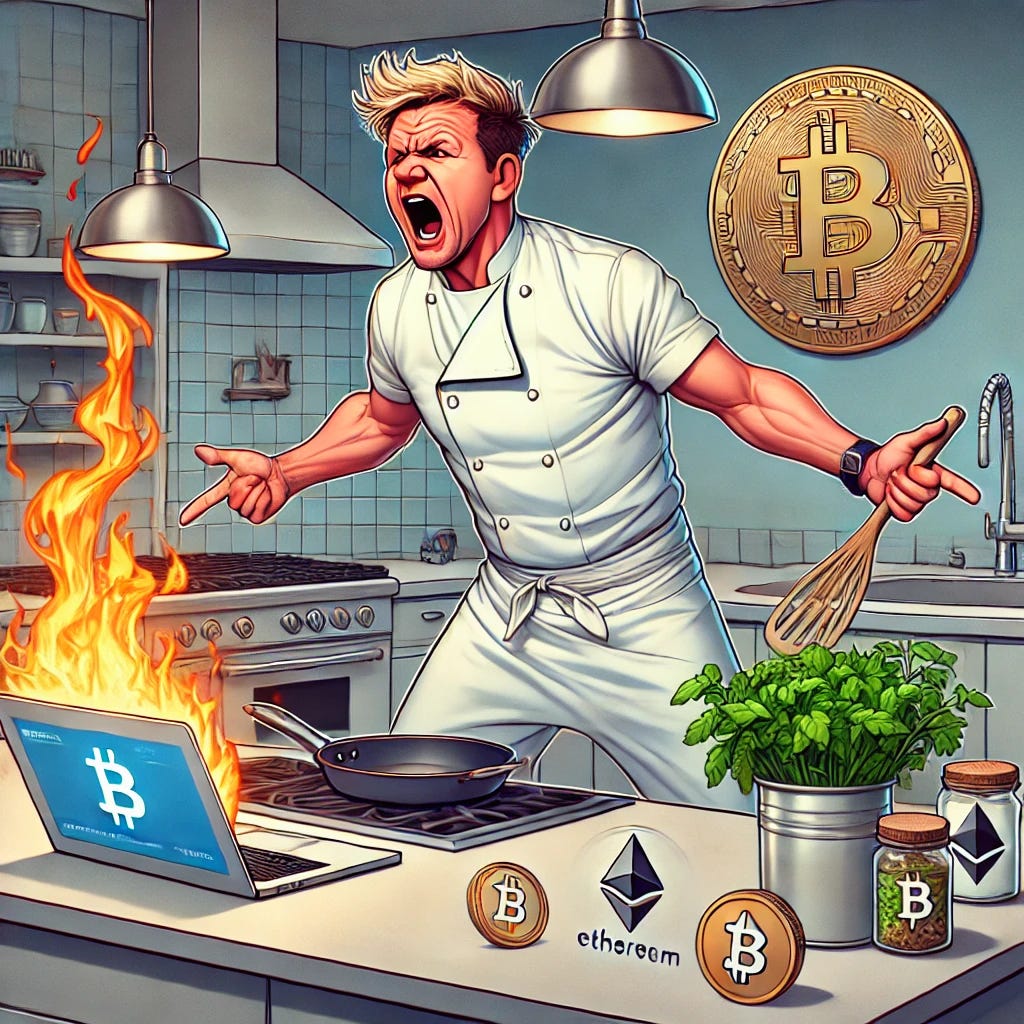Taste is the common sense of genius. – Victor Hugo
Bitcoin’s design is set in stone. The core is completely decentralized with no server or central authority. - Satoshi Nakamoto
We rise to the level of our systems, not the want of our goals. - James Clear
Whether you’re a bell ringer at Notre-Dame or a French revolutionary, Victor Hugo thinks that taste is for you. That having taste is not just for the elite, and is in fact, an individual system that helps us rise beyond central authorities, and establish our own systems of selection in many areas of life.
For those of us in crypto, as the price of Bitcoin (at the time of writing) nears $100,00, we’re faced with the challenge of developing a taste in tokens for the future. Do I only want bitcoin? What’s my taste in other tokens? Which system will I use to develop said taste? Who am I? (Les Mis fans feel free to sing the rest)
Historically, my definition of ‘taste’, is voiced with an audible “ugh”, as I’ve seen taste as a proxy for snobbery, and I’ve had little patience for coffee snobs, wine snobs, food snobs, label snobs, you get the picture. However, I’ll argue in this piece that taste is merely a sensibility, and snobbery is only one way to express that sensibility. Importantly, it’s not the only way.
Another definition of “good taste” is having a well-formed opinion, in accordance with the realities of the good and the true. (attributed to John Folley). In this light, taste is a discerning choice based on quality and resonance. Taste reveals thoughtful decision-making, not just arbitrary preference. I like this.
Taste is also a pursuit of the uniquely authentic. (George Saunders calls this the ‘iconic space’) Here we view taste beyond aesthetics, and make it all about authenticity, cultivating a perspective, and elevating what’s uniquely valuable. I really like this.
And while some equate taste with expense, forget it, it’s not about the price tag, we just wanna make the world dance:)
And, as crypto investors we must ask; Are we overpaying for what our taste actually dictates? True taste isn’t about luxury for luxury’s sake; it’s about distinguishing quality wherever it exists.
Both value and quality are familiar factors for developing taste in equities, but for crypto assets, as we’ll see, it’s not as easy as copy/paste.
There’s this wonderful Picasso’s quip I like about artists discussing where to buy cheap turpentine rather than abstract theory about art. Basically, artists don’t sit around and talk about art, they sit around and talk about the fundamentals that go into creating the art.
For crypto the “turpentine” could be cheap blockspace, MEV, fees from transactions, acceleration of wallets. The heart of quality in crypto lies in understanding the fundamentals, not just price movements. Critics may discuss price, but crypto’s “tasteful” community is more concerned with innovation, decentralization, and real utility. And yes, f#4ing really good memes!
Fundamentals drive factors, and a new structure must emerge.
Taste the resistance
New flavors are a good thing.
What we have to realize here is that the same metrics that have worked with valuing equities might not directly map to the crypto ecosystem. Companies like AQR took off from simply doing a better job at systematically looking at data. Generating, now common factors, like value and quality. Things will be different in crypto. What does quality and value mean in crypto? We’re using some similar metrics; e.g. fees, users, transaction counts, but we need to dig deeper and look at them in absolute, relative and growth terms. This research alone is enough to make your head spin, and we haven’t even spoken about getting good data in crypto. The discrepancy across crypto data providers is what makes this task not only so interesting, but also difficult. See example 1 below: Thanks to Outerlands Capital
Taste the TAM
Develop a taste for tokens that solve problems.
And while at times it doesn’t look like use cases matter with meme coins dominating much of the sentiment for alts this cycle, I’d argue that memes are indeed a use case that we’ve just yet to catch up to and learn to measure. They’re fast, they’re fun, they’re cultural and when you know about them it’s probably too late. There’s value in this and it’s our job ‘not to judge’, but to call balls and strikes and see if memes are in our taste profile. Memecoins are up a ridiculous 261% YTD (as of the writing of this article) and that’s not to be ignored. I imagine over time we’ll figure out a way to value these pieces of culture. After all, aren’t memes just art at the speed of the internet?
And the same goes for other areas that are being disrupted by web3. We need to make sure we’re identifying the problems that each token solves and look at them as uniquely as possible, especially as it relates to the size of the problem they’re solving. For example, in traditional finance, you would analyze a bank very differently than you would analyze an industrial company. The same logic applies to tokens as the TAM and valuation methodology/metrics are different for a gaming project, L1, L2, DEPIN, AI, currency, smart contract platform, DEX, DeFi bridge, the list goes on.
Looking for good investments not just good companies;
Ok, so you’ve developed the taste in and for tokens. You’re ready to dig in. However, a key piece of wisdom to share is that we’re looking for good investments not just good companies.
This phrase encapsulates the idea that not all great companies make great investments. It's about identifying opportunities where the valuation and growth potential align to generate strong returns, rather than simply admiring the quality of a company.
The nuance here lies in focusing on the price you pay versus the value you get. A "good company" might have excellent management, robust financials, and a strong market position, but if the token is overpriced, it might not yield a good return. Conversely, a "good investment" could be a less glamorous opportunity with mispriced value or untapped potential.
Look for these ingredients:
Valuation Matters
Market Cap vs. Fully Diluted Valuation (FDV): A project with a low market cap but a high FDV might dilute token value as more tokens are issued.
Total Value Locked (TVL): For DeFi protocols, compare TVL to market cap. A high ratio might indicate overvaluation.
Adoption and Revenue Growth: Are people using the network, and is it generating transaction fees or other revenues?
Avoid Overhyped Projects: Many "blue-chip" crypto tokens become overvalued due to speculation and hype cycles. Look for under-the-radar projects with solid fundamentals.
Tokenomics and Incentives
Utility and Demand: Does the token have a real use case? E.g., does it power a blockchain, secure a network, or serve as a medium of exchange in a growing ecosystem?
Inflation and Supply Schedule: If a token’s supply is inflating rapidly due to staking rewards or liquidity mining, price appreciation becomes harder.
Burn or Revenue-Sharing Models: Look for tokens tied to mechanisms that reduce supply or distribute protocol revenues (e.g., Ethereum’s EIP-1559 burn or GMX’s revenue-sharing model).
Identifiable Catalysts
Protocol Upgrades: Changes that improve functionality, scalability, or security (e.g., Ethereum’s Merge).
Adoption Growth: Partnerships, integrations, or increased user base.
Regulatory Clarity: Events that make the project's value proposition more accessible to institutions or users.
A common pitfall is to watch how a supply unlock is being viewed by the community in either discord or on crypto twitter. Are they happy? Pissed? Are VCs and insiders getting the lions share of the tokens? Be on the lookout for the next supply unlock in your ecosystem and what token holders are saying. Taste in this case is crowdsourced.
Does having taste lead to financial gains?
The process of developing taste takes time. Crypto investing with taste might feel slower, but the projects that prioritize foundational value and community alignment are often better equipped for longevity.
Taste allows investors to curate tokens that show consistency and quality over time.
Projects with a foundation of taste are likely to attract users and adapt to new challenges, making them more resilient over the long haul. Taste in crypto allows for the selection of projects that will stand out in a volatile market by contributing real value to the ecosystem.
Bitcoin, the grandaddy of them all, is an acquired taste for some but the ultimate in discretion for others. Our world runs on stories and having taste is no different. For Bitcoiners, money is not the root of all evil, money is the root of all sovereignty. Money is a digital property right to our time, and we then get to trade our time for money. Which we then use to buy stuff, services, & experiences. When a central government prints money, our time is stolen (which is not ok) and developing the sophisticated pallet to taste this, most likely, means you’re a Bitcoiner.
Another taste you may develop is that of the community altruist. Money is the greatest force for good in the world today. It helps lift people out of poverty around the world. And the more we can help those on the fringes of our society develop the taste for what Bitcoin and crypto brings to their lives, as they look to escape the accelerating fiat flood, the better. (credit to Ross Stevens here)
Developing this type of taste for tokens is something we can all get behind.
Did you find the answer to who you were? 24601?





